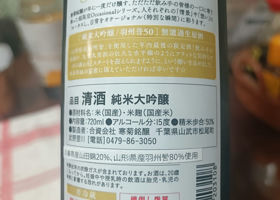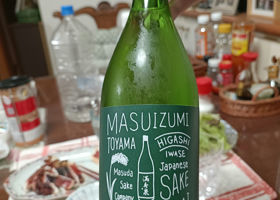Timeline
hidekitakakoIt is light, light, and not too sweet.
It is easy to drink, so it goes down smoothly.
This ease of drinking is superb.
There are many self-proclaimed modern sake that are too sweet
but the sake like this one is elegant and refreshing.
but an elegant and smooth sake like this one is rare and precious.
This is a fine example of a middle-of-the-road sake that can be enjoyed by both classicists and modernists.
both classicists and modernists can enjoy this sake. hidekitakakoIt is light and very easy to drink. It is not too sweet and has a very sharp taste. Since it is not too assertive, it has an excellent taste as a food wine that can complement the main dish well. However, because it is so easy to drink, please be careful not to drink too much and become tongue-tied. hidekitakakoIt is smooth and easy to drink. It is smooth and crisp. It is very elegant and pleasant to drink. When drunk as a food wine, it will stand up to the food. It goes well with food. Modern sake these days is too sweet. This is not sweet. But it is just like a fine water, and you can choose who you want to drink it with. A young sake brewery that asserts itself with gusto is also reliable, but what an experienced sake brewer can achieve is the comfort of drinking with enlightenment, like Bhutta, and the gentleness that allows it to coexist with food. However, such sake is not easy to make. The toji's enlightenment will surely move our hearts and tongues as well. hidekitakakoIt is a sweet and dark first impression. It also has a sour and sparkling taste. There is no cloying taste and it is easy to drink. Personally, I think it would be more elegant if it were a little less sweet. I would like to drink it as a food sake, so I think it would be a mature sake that brings out the best of food flavors if it were less sweet. hidekitakakoIt seemed to be flavored somewhere between classic and not too sweet and not too modern. The taste is light and easy to drink, but it could be said to have a taste that could be found anywhere. It is easy to drink, but it could be said to have a taste that could be found anywhere. hidekitakakoAccording to the owner's explanation, the newly established Sanroku brewery, which will be introducing a new product this year, is a brewery where soft water is pumped up, and this soft water was brought to the existing brewery to be balanced with the existing brewery's ultra-hard water to create an ambitious test brew.
As far as I can tell, it tastes sweet. It is sweet, but there is no cloying taste. It had a fruity flavor that women would appreciate. I have the impression that it is exactly the kind of taste that Kaze no Mori specializes in. Personally, I wish they would aim for a new taste targeting adult women with a little less sweetness. This is because while sweetness makes it easy to drink, it also makes you tired of drinking it too soon. The product will be marketed as a new brewery product in a few months. We are looking forward to it. hidekitakakoIt's sweet, but a bit habitual.
It's a disappointing taste for a sake made by Kangiku Shuzo.
There is no fruitiness.
It tastes a little out of the ordinary for my favorite Kangiku.
It tastes a little out of the ordinary for my favorite Kangiku sake. hidekitakakoIt is truly a sparkling sake. The carbonation is not very strong. The sake did not pop out when I uncorked it.
It had a fruity flavor with no cloying taste, a modern type of flavor that is becoming the mainstream today. I had the impression that it was easy to drink. hidekitakakoIt has a sweet flavor. The label states that it was a trial and error process to express the citrus aroma of lime and lemon and the green nuance of herbs. I thought, "Really? In addition to the sweetness, there is a tangy taste. It is a sweet taste, but there is no citrus aroma. Perhaps someone with a keen sense of taste would be able to detect such nuances, but to an amateur, it was just a tangy taste. I have a feeling that there are a lot of self-satisfied breweries like this one these days. When I drink a variety of sake, I realize that as long as it is made with rice and koji, the taste generally falls within this range. I wonder what it is like to sell sake with sweetness and miscellaneous flavors by forcibly claiming that it is fruity. hidekitakakoIt is amakuchi, but it is smooth and has a nice sharpness. As the name "cool" suggests, it goes down your throat easily when drunk chilled. Most summer sake is light in flavor, in fact, many of them are lightly flavored, but this sake has a solid body. This is a long-established sake brewery that provided Nagareki No. 9 yeast. I feel that this brewery's most appealing feature is its thick core presence. hidekitakakoIt is named "Natsumushi" (summer insect), which means it has a light and refreshing flavor suitable for summer. It is not too sweet and not too dry. It is as easy to drink as water, but can also be described as tasteless like water. However, it is named Natsumushi because it is meant to be drunk as lightly as water, and to seek depth in this type of seasonal sake would be to expose the ignorance of the drinker. hidekitakakoFruity and shwashy. The sweetness is smooth and light. It has a good sharpness. The balance of drinkability is very sophisticated, and it is an ambitious urban work brewed in Kujukuri that is typical of a brewery representing modern sake. It is so easy to drink that you will find yourself drinking a four-pack in no time. hidekitakakoAlthough it is a sweet wine, its sweetness is moderate and not overbearing. It has an elegant taste that is liked by both the rich umami group and the light dry group. Because it is not too assertive, it is a very good sake for a meal, and it is a dexterous sake that is well-balanced in its modesty. It is a modest sake in terms of character, but as a sake that accompanies a meal, it is a first-rate host. The essence of Japan is the art of accompanying, and this is a valuable sake brewery that is a leader in pure Japan, a sake that can only be obtained by those who have acquired this art. KLight and easy to drink, but the taste leaves a strong umami flavor.
Beautiful balance of sweet and sour at the entrance.
If you call it a berry type, well...
Great value for money, but I think I raised my expectations too high.
It is easier to feel the beautiful balance of sweet and sour when it is closer to room temperature.
4.25 hidekitakakoIt is fruity but has a good sharpness and does not linger.
It is full of smooth flavor and is not cloying.
It is easy to drink and has an elegant atmosphere.
It is very delicious. The degree of this persistency strongly suggests the high sense of the winemaker. sikamaruAbe after a long time. It has a pleasant slight gasiness and a mild sweetness and umami. However, as a whole, it is refreshing and has a good sharpness. It is a hospitable sake that goes well with any occasion. sikamaruI've had my eye on red and white for a while. After much hesitation, I chose the white one. The aroma is quite strong with lactic acid bacteria like yogurt. Is it a feeling I don't like? But the taste is not lactobacillus feeling. It is a strange feeling. But the taste is rather full, and it is beautiful but drinkable. I wonder what the red is like. disryI have a feeling that the heat will gradually ease from this week. Sake season is about to arrive. So, I opened a bottle of Sairai.
I thought it was too sweet right after opening the bottle, but it lasted about 3 days! But after about 3 days, my impression changed a little.
The aroma was mild lactic acid. I didn't feel the usual peach aroma. There is a slight gassy feeling, but not too much.
The sweetness is less pronounced than on the first day, but still strong. Delayed, but still quite strong acidity.
In the second half, the acidity and bitterness come with a bang, and finally the bitterness joins in for the finale. The strong sweet, sour, and bitter flavors continue until the aftertaste.
It is quite unique and assertive. I wonder if Sairai is like this.... It would have been better if it was a little easier to drink.
disryIt's here again this year, the tasty cold chrysanthemum. I was in a hurry, but I managed to get it.
The aroma is pineapple. Tropical atmosphere. The gasiness is quite strong.
It has a refreshing sweet acidity that is neither too strong nor too weak. It has a good aroma of rice and a strong umami flavor.
The acidity and umami continue with a slight bitterness at the end. The lingering bitterness stimulates the tongue.
This year, too, it was delicious and very satisfying. I think I will buy another bottle. URUさけ|生酛好き🌾Raw rice (production area): Asparagus: Yamada Nishiki, Kake: Gohyakumangoku
Yeast.
Refined rice ami(%):50
alc(degree): 16
Japaneseness: +2
Acidity: 1.7 RecommendedContentsSectionView.title






























































